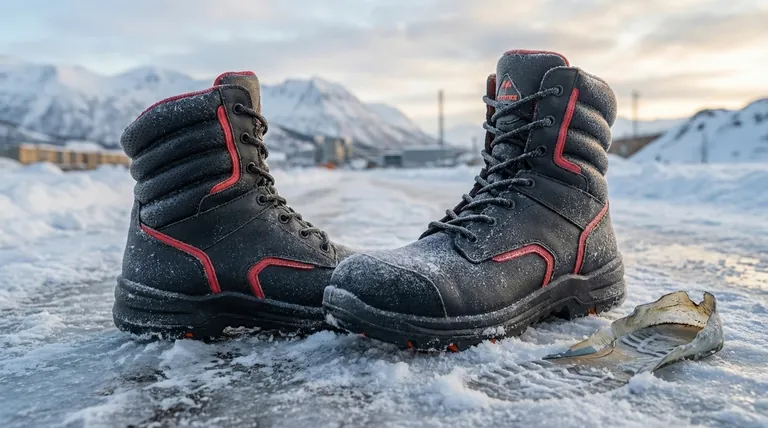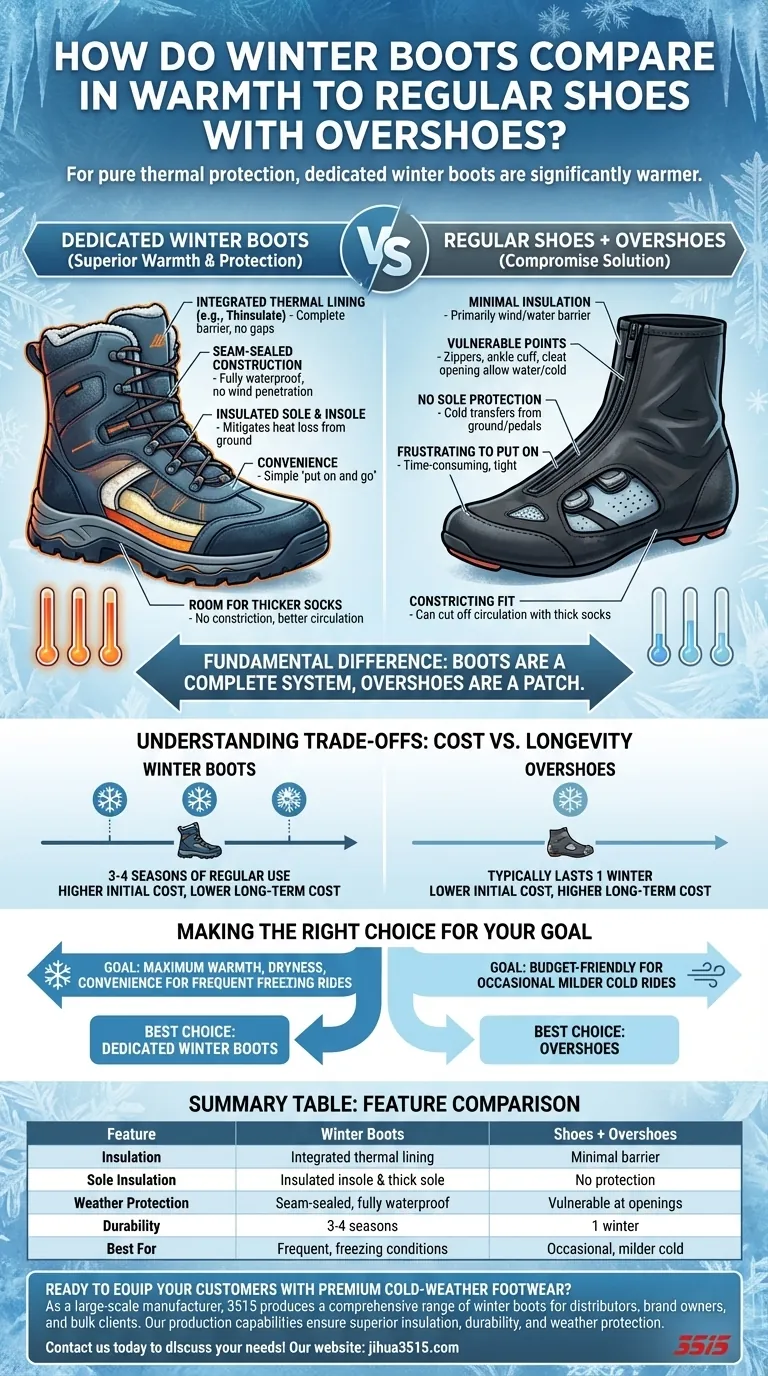For pure thermal protection, dedicated winter boots are significantly warmer than a standard shoe and overshoe combination. Their integrated insulation, weather-sealed construction, and purpose-built design provide a superior barrier against the cold that an add-on cover simply cannot match.
While overshoes offer a degree of protection, they are fundamentally a compromise. True winter boots provide a comprehensive solution for warmth, waterproofing, and durability that is more effective and, in the long run, more cost-efficient for serious cold-weather use.

The Fundamental Difference in Insulation
The core reason for the performance gap lies in how each system is constructed. A winter boot is designed from the ground up as a single, insulated unit, whereas an overshoe is a patch on a system not built for the cold.
Integrated Thermal Lining
Winter boots feature insulation, such as Gore-Tex or Thinsulate, built directly into the boot's structure. This creates a complete thermal barrier that surrounds your entire foot—top, bottom, and sides—without any gaps.
Seam-Sealed Construction
A dedicated boot is a sealed system. It lacks the large ventilation ports found on standard shoes and has fewer seams, which are typically taped or sealed to prevent wind and water from penetrating.
The Sole Problem
A significant amount of cold transfers from the ground and pedals directly through the sole and cleat of a regular shoe. An overshoe does nothing to insulate this critical area, leaving a major thermal weak point. Winter boots, in contrast, often feature insulated insoles and thicker soles to mitigate this heat loss.
Beyond Warmth: Practical Advantages of Boots
The benefits of winter boots extend beyond simple insulation. They offer a more convenient and robust solution for challenging conditions.
Superior Weather Protection
Because they are a single unit, winter boots provide far better protection against rain, sleet, and snow. Overshoes have vulnerabilities at the zipper, ankle cuff, and cleat opening, which are common points of water ingress.
Convenience and Simplicity
Putting on tight neoprene overshoes over shoes can be a frustrating and time-consuming process. Winter boots are a simple "put on and go" solution, which is a significant advantage, especially when you're getting ready in the cold.
Room for Thicker Socks
The interior volume of a winter boot is designed to accommodate thicker wool or thermal socks without constricting your foot. Trying to fit thick socks into a snug-fitting regular shoe, even with an overshoe, can cut off circulation and ironically make your feet colder.
Understanding the Trade-offs: Cost vs. Longevity
While the performance benefits are clear, the primary consideration for many is the cost. However, the true value emerges when you look at the lifespan of each product.
The Initial Investment
There is no question that winter boots carry a higher upfront price tag than a pair of overshoes. This initial cost can be a significant barrier for those who only face cold weather occasionally.
The Long-Term Value
Durability is where boots prove their worth. A good pair of winter boots can be expected to last three to four seasons of regular use. In contrast, overshoes, with their delicate zippers and thin material under the foot, often last for just one winter.
When Overshoes Still Make Sense
Overshoes are not without their place. They are a viable, budget-friendly option for transitional seasons like fall and spring or for riders in climates with milder winters where full insulation is overkill. They provide a necessary boost of wind and water resistance for shorter rides in chilly, but not frigid, conditions.
Making the Right Choice for Your Goal
Your decision should be guided by the conditions you face and your long-term goals.
- If your primary focus is maximum warmth, dryness, and convenience for frequent riding in freezing temperatures: Dedicated winter boots are the superior and more economical long-term investment.
- If your primary focus is a budget-friendly solution for occasional rides in milder, chilly conditions: Overshoes provide a sufficient and flexible layer of added protection.
Ultimately, investing in the right footwear for the conditions is the most critical step you can take to ensure comfort and safety in the cold.
Summary Table:
| Feature | Winter Boots | Shoes + Overshoes |
|---|---|---|
| Insulation | Integrated thermal lining (e.g., Thinsulate) | Minimal, primarily wind/water barrier |
| Sole Insulation | Insulated insole and thick sole | No protection from ground cold |
| Weather Protection | Seam-sealed, fully waterproof | Vulnerable at zippers and openings |
| Durability | 3-4 seasons with regular use | Typically lasts 1 winter |
| Best For | Frequent use in freezing conditions | Occasional use in milder cold |
Ready to equip your customers with premium cold-weather footwear?
As a large-scale manufacturer, 3515 produces a comprehensive range of winter boots for distributors, brand owners, and bulk clients. Our production capabilities ensure superior insulation, durability, and weather protection—exactly what your market needs for serious winter conditions.
Contact us today to discuss how we can help you offer the best in winter footwear!
Visual Guide

Related Products
- Premium Wholesale Waterproof Safety Boots High Performance Protection for Industrial Markets
- Wholesale Safety Footwear Manufacturer for Bulk & Custom OEM Orders
- Customizable Anti-Smash Safety Boots for Wholesale & Private Label Manufacturing
- Custom Wholesale Leather Safety Boots Direct Factory Manufacturing
- High Performance Fire-Retardant Waterproof Safety Boots
People Also Ask
- What are some examples of footwear requirements in different work settings? Ensure Safety and Compliance
- Is there a downside to steel toe boots? Weighing Protection Against Daily Comfort
- What are some real-world examples of safety footwear preventing injuries? Protect Your Workforce Effectively
- What are the key considerations when choosing safety boots? Match Hazards to Features for Maximum Protection
- How do safety shoes protect you? A Guide to Essential Footwear Safety Features



















